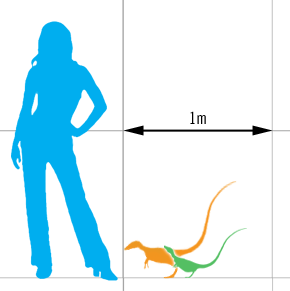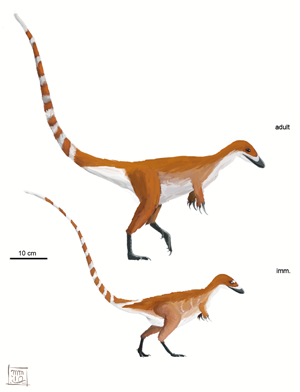home > natural history
Sinosauropteryx prima
"first Chinese reptilian wing"

click here to buy a print
Sinosauropteryx prima was the first non-avialan dinosaur ever found with feather impressions, finally confirming decades of speculation that, due to their close relationship with birds, many theropod dinosaurs may have been covered in featehry coats. Though the prior discovery of Avimimus implied the presence of feathers thanks to quill knobs on the wing bones, the idea wasn't widely accepted until after Sinosauropteryx was described in 1996. Sinosauropteryx is known from several specimens, mostly found near the Chinese city of Beipiao in Liaoning province. All specimens preserve feathers, and at least one even preserves stomach contents (a lizard) and the remains of internal organs, even the eye.
The specimens are so well preserved, in fact, that they contain information about the animal's color in life. Several specimens show a distinct banding pattern in the preservation of the tail feathers. Initial studies dismissed these as an artifact of the way the two slabs making up the holotype fossil were split, but examination of both slabs show that the gaps on one side are not filled by feather bands on the other--in fact the dark bands seem to correspond directly to their mates across both slabs. Studies of feather fossilization (as well an SVP presentation by Nick Longrich, involving studies under UV light) suggested that the dark banding represents the preservation of melanin, indicating dark-colored feathers, while areas where feathers were not preserved may imply the presence of white or light colored feathers, showing that Sinosauropteryx was counter-shaded (white on bottom, dark on top) with a banded tail. This was confirmed by studies of the microscopic structure of the feathers, showing that melanin was preserved, and that exact colors could be worked out using the shapes of the melanosomes. These studies allowed scientists for the first time to reconstruct the life coloration of a dinosaur--in this case, Sinosauropteryx was shown to be russet or ginger colored with lighter stripes.
The digital painting above reflects the preserved coloration, but also takes a bit of artistic license in restoring scales to some apparently featherless areas: this is based on the presence of a partially scaly underside and legs in otherwise feathered dinosaurs like Scansoriopteryx and Juravenator. The field guide illustration at right features a more conservative depiction of both the juvenile holotype specimen and an adult individual. At least one of the larger, mature Sinosauropteryx specimens probably belongs to a different species or even genus (see Sinosauropteryx sp.).
The scenery surrounding Sinosauropteryx in the painting above includes plant life found in the same lower Yixian Formation deposits. Dominant plants in this lakeside forest included large conifer and ginkgo trees (background and right), numerous horsetails (far left, with white buds), and one of the earliest known flowering plants and earliest carnivorous plant, the pitcher plant Archaeamphora (center left). The Sinosauropteryx in the painting is investigating another common Yixian animal, Epicharmeropsis, a mayfly similar to those alive today.
.
.
.
.
.
.
.
Image Details:
Media: Digital painting, Adobe Photoshop CS3
using WACOM Graphire 3
License:
ALL RIGHTS RESERVED
DESCRIPTION
Length: 1.3m (4.2ft)
Weight: 260g (9oz)
Location: Yixian Formation, Liaoning, China
Time: Aptian age, Lower Cretaceous (125Ma)
CLASSIFICATION
Kingdom: Animalia
Phylum: Chordata
Class: Stem-Aves
Order: Compsognatha
Family: Compsognathidae
Genus: Sinosauropteryx
Species: S. prima
SYSTEMATICS
Sauropsida
Diapsida
Archosauria
Ornithosuchia
Dinosauria
Theropoda
Coelurosauria
Comosognathidae

